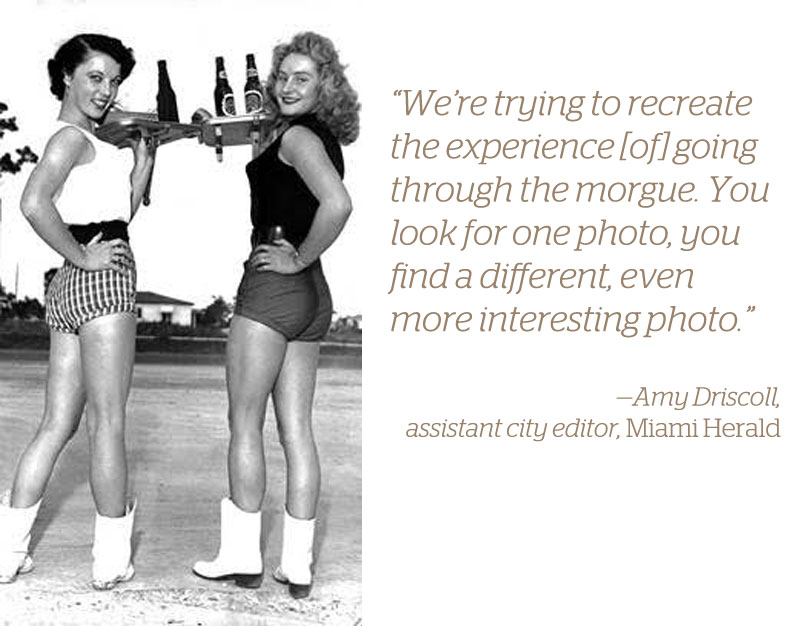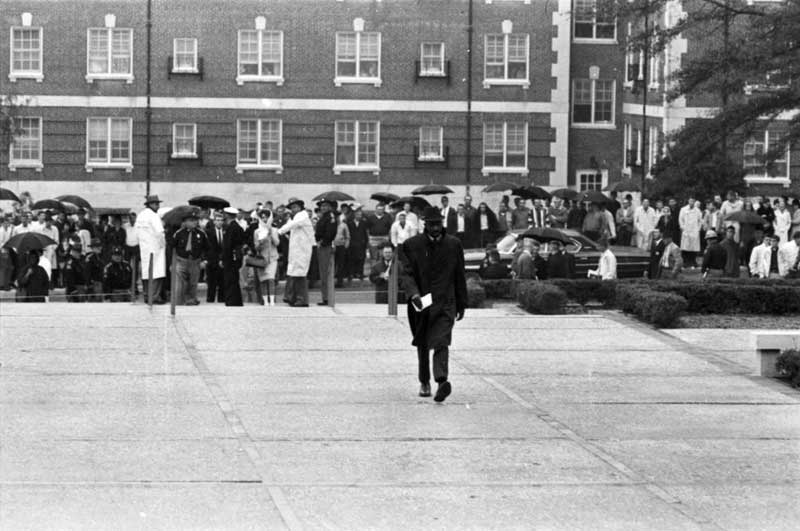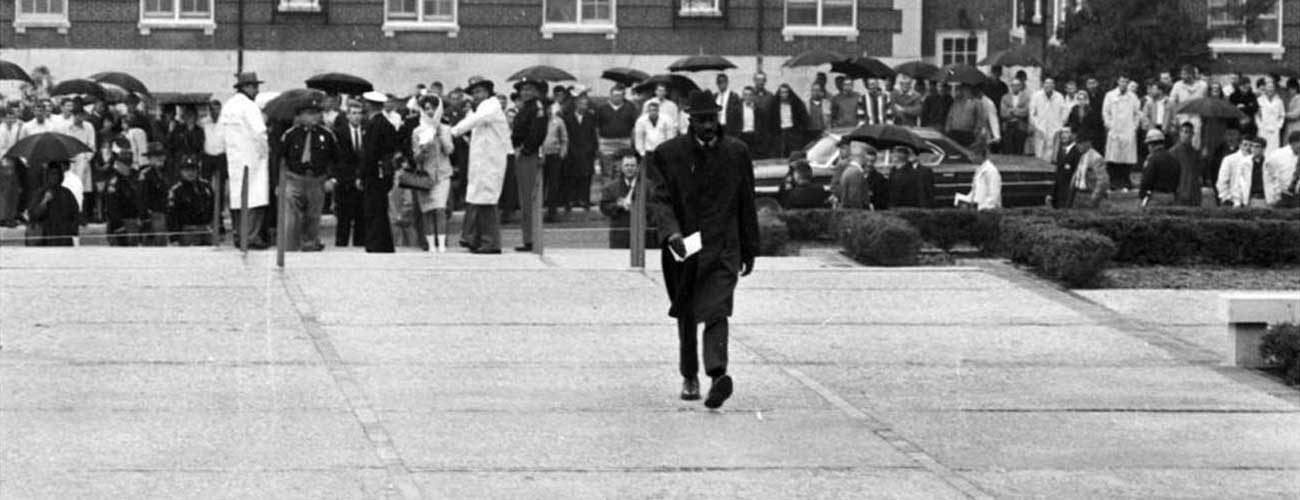Newspapers may provide the proverbial “first rough draft of history”—though the provenance of that phrase may itself have been lost to history. But when history moves on, are there still ways to mine value from all that accumulated material, much of it sitting in dusty file cabinets?
Two newsrooms in the South believe there is. Papers in Alabama and Florida are digging through their photo archives, seeking—in different ways—not only to inform and entertain their readers, but engage their communities.
The simpler of the two projects is The Miami Herald’s Flashback Miami, a freestanding site that features curated collections of photos from the paper’s archives. The project is the brainchild of Amy Driscoll, an assistant city editor, and Monika Leal, the paper’s director of information services.
The project was designed to “give you a feel for what’s been here before,” said Driscoll. “In Miami, we haven’t always valued our past.” The collections showcase historic shopping districts, prime minister’s visits—and, of course, Miami’s more glamorous and seedy sides. Some of the most popular posts include one on Miami’s “cocaine cowboy” days, and another on Miami Vice that Driscoll and Leal timed to run around the 30th anniversary of the show.
“Miami Vice was such a turning point for Miami,” said Driscoll. “It really changed Miami for the better. That post continues to do well. So does the drug war post—the cocaine cowboys, the square grouper, all of that.” (“Square grouper” is a Miami term for bales of marijuana found floating in the ocean or washing up on the beach. They became so ubiquitous they required a name.)
The presentation underscores that the photos are the work product of journalists, made for use in newspapers. A fabulous collection of car-hop hotties from the ‘50s includes the cutline information typed on the back and choice lines from the accompanying story, along with images of the actual newspaper pages where the pictures appeared. Other photos show the red pencil crop marks made on the original print.

This photo of two car hops carrying trays of Schaefer beer was taken in 1954 by Miami Herald staff photographer John Walther, probably for an article that ran June 11 of that year. The Flashback Miami site features this line from that article: “Drive-ins depend on autos for business, and a lot of auto drivers are men, and when a hungry man spots a gal clad in recklessly brief shorts and a tight sweater, he’ll drive blocks out of his way to stop and gape while he gobbles.” Courtesy Miami Herald.
Driscoll and I are good friends and worked together at the Herald and The Palm Beach Post. “We’re trying to recreate the experience you and I had going through the morgue,” she told me. “You look for one photo, you find a different, even more interesting photo.”
The Herald won’t release specific numbers, but she said the nearly two-year-old project has seen 70 percent growth year-over-year in unique visitors; popular posts draw a couple thousand Facebook interactions. The site isn’t set up to take ads, but it is selling copies of the photos, through a vendor. (A different vendor digitized the archived photos, in exchange for rights to sell the hard copies.)
“Every time we do a popular post, we sell more photos. We’d love to have it make money but really, it’s a public service,” Driscoll said. “There’s no extra cost, except our time”—a day every few weeks to compile posts.
The second project comes from Advance’s Alabama Media Group, which owns the Birmingham News, The Huntsville Times, and Mobile’s Press-Register—and it has a similar public service goal, though it is a more complicated undertaking.
To begin with, the Alabama papers have to digitize the photos of the three newspapers, which each had different archiving systems. And while the Herald’s photos were catalogued according to subject, the Alabama photos are in envelopes that represent a specific photographer’s assignment for the day, sometimes with nothing more than the name of the photographer and the year. So the papers are looking for community partners to help out with the task of digitizing and cataloguing the photos, and for information on the people and places they depict.
“We’ve lost a lot of institutional knowledge,” said Scott Walker, the director of strategic initiatives at Alabama Media Group, who is working full-time on the project. “We’re reaching out to the community to fill in the blanks, getting the audience involved.”
AL.com, the umbrella site for the three papers, experimented in the spring with posting vintage photos, collaborating with the University of Alabama to produce a project on a Grateful Dead concert 20 years ago. A class of journalism students dug up the stories behind the photos, many of which had never been published. The “Lost Stories” project, a collection of posts and a slideshow of vintage photos, drew more than 325,000 pageviews. A more recent installment in the partnership explores the history of Birmingham’s Beaux Arts Krewe Ball.
This fall, the site launched “AL.com Vintage,” to showcase more finds from the photo archives. Walker told me the Alabama papers found that the biggest files in their archives were devoted to three topics: the Civil Rights Movement, football, and beauty pageants. A recent post on coverage of the first black student to integrate Auburn University includes a somber shot of Harold Franklin walking alone past a group of white students, his coat collar pulled up against the cold.

This photo from the archives of The Birmingham News shows Harold Franklin on Jan. 4, 1964, when became the first black student to enroll at Auburn University. The paper’s photographers that day were Tom Self and Ed Jones. Courtesy AL.com.
Like the Herald, the folks in Alabama are trying to give readers a look not just at individual photos, but at the way they were kept and how that reflected the times.
“We’re trying to pull back the curtain a little bit, give people a peek at what we have in our collection and how they’re filed, how they’re labeled,” Walker said. “The language changes. Back in the 1960s, the envelopes were labeled ‘Negro.’”
While the Herald’s archive is generally better catalogued than the archives in Alabama, Driscoll has found digging up information that explains the photos to modern readers is often the most difficult task. And the Herald’s archive includes plenty of misfiled photos, or categories that were used differently over the years.
“You’re looking for Muhammad Ali and you find Jackie Gleason,” she explained. “If you look under ‘art deco,’ there is not as much as you might expect, but then you find there’s more under ‘preservation’ or ‘architecture.’ To get this fully searchable would require local knowledge and a whole lot of time”—so it’s easy to understand why the Alabama papers are looking for partners.
We’ve written before at CJR about how newspaper photo archives are a unique resource—at the Chicago Tribune, an Instagram account dedicated to vintage photos has been surprisingly popular.
“The workflow can be cumbersome; the photos that followers like don’t always have much news value, and there are few opportunities to generate revenue or even link back to a news organization’s website,” my colleague Jackie Spinner wrote. “But it’s hard to ignore the potential to engage, and expand, an audience.”
They’re operating in different formats, but both the Herald and the Alabama papers seem to be taking that message to heart. And readers seem to appreciate it—even the skeptical ones. As one Alabama commenter put it on a presentation of fashion shots from 1967, “I don’t normally have many good things to say about AL.com, but this this is fantastic!”
Susannah Nesmith is CJR’s correspondent for Florida, Georgia, and Alabama. She is a freelance writer based in Miami with more than 25 years working for regional and national outlets. Follow her on Twitter @susannahnesmith.

